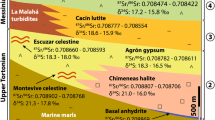Abstract
In the Guaymas Basin of the Gulf of California, changes in the mineral and chemical composition of sills of different thicknesses were studied in hydrothermal systems, which originated during the intrusion of the hot sills into young (Pleistocene) cold seawater-saturated sediments. Holes DSDP 477 and 477A were drilled in a high heat flow area, and holes 478 and 481/481A, in a low heat flow area. Thick sills from holes 477, 477A, and 478 (47, 30, and 112 m, respectively) remained fresh or very weakly altered because water released from the host Pleistocene sediments upon heating practically did not penetrate them. Olivine (a few wt %) in the sills remains unaltered, whereas mesostasis also amounting to a few percent is replaced by clay minerals. The high heat flow alone, without water input, could not provide favorable conditions for the changes in the mineral and chemical composition of thick sills in holes 477 and 477A (1250 mW/m2). The thin (from 0.1 to 0.65 m thick) and relatively thin (from 1.2 to 4.5 m) sills recovered in holes 478 and 481/481A were altered. They are fractured and therefore favorable for the penetration of water released from heated host sediments. In addition, a large volume of these sills is occupied by mesostasis (mainly from 18 to 45%, reaching in some samples from 53 to 70%) variably replaced by clay minerals. Olivine is frequently completely replaced by clay minerals. The alteration of thin basalt sills is accompanied by a sharp decrease in the K content, which in some cases is accompanied by an insignificant decrease in Mn, Mg, P, Na, and Ti. The low heat flow measured in the areas of holes 478 and 481/481A (150 and 165 mW/m2) indicates that the established mineral and chemical changes in the thin sills were caused by auto-hydrothermal processes, without heat and mass impact of convective long-lived hydrothermal systems.









Similar content being viewed by others
REFERENCES
E. V. Blinova and V. B. Kurnosov, “Hydrothermal alterations of sediments in the southern trough of the Guaymas Basin (Gulf of California) and transformation of the composition of solutions,” Lithol. Miner. Resour. 50 (6), 433–451 (2015).
E. O. Goncharov, V. B. Kurnosov, Yu. I. Konovalov, A. R. Geptner, K. R. Galin, and N. N. Ignatyev, “Hydrothermal altered sediments from contact zones with sills in the north trough of the Guaymas Basin, Gulf of California,” Okeanology 60 (1), 98–107 (2020).
V. B. Kurnosov and E. V. Blinova, “Hydrothermal alteration of sediments and compositional evolution of solutions in the Guaymas Basin of the Gulf of California,” Dokl. Earth Sci. 461 (1), 217–220 (2015).
V. B. Kurnosov, B. A. Sakharov, and E. V. Blinova, “Clay minerals in sediments of the hydrothermally active southern trough in the Guaymas Basin (Gulf of California),” Lithol. Miner. Resour. 51 (4), 243–261 (2016).
V. B. Kurnosov, B. A. Sakharov, A. R. Geptner, Yu. I. Konovalov, and E. O. Goncharov, “Clay minerals in sediments from contact zones with basalt sills,” Lithol. Miner. Resour. 54 (3), 221–235 (2019).
V. B. Kurnosov, B. A. Sakharov, A. R. Geptner, Yu. I. Konovalov, and E. O. Goncharov, “Clay minerals in sediments from the central part of the Guaymas Basin, the Gulf of California, Hole 478,” Russ. J. Pac. Geol. 13 (5), 479–491 (2019).
V. B. Kurnosov, B. A. Sakharov, A. R. Geptner, Yu. I. Konovalov, and E. O. Goncharov, “Clay minerals in basalt sills from the sediment cover, East Pacific Rise,” Lithol. Miner. Resour. 55 (2), 152–164 (2020).
J. R. Curray, D. G. Moore, J. E. Aguayo, et al., Init. Reports Deep Sea Drilling Project 64, 507 (1982).
G. Einsele, “Mechanism of sill intrusion into soft sediment and expulsion of pore water,” Init. Repts. DSDP 64, 1169–1176 (1982).
J. M. Gieskes, M. Kastner, G. Einsele, K. Kelts, and J. Niemitz, “Hydrothermal activity in the Guaymas Basin, Gulf of California: a synthesis,” Init. Repts. DSDP 64, 1159–1167 (1982).
M. Kastner, “Evidence for two distinct hydrothermal systems in the Guaymas Basin,” Init. Repts. DSDP 64 (2), 1143–1158 (1982).
K. Kelts, “Petrology of hydrothermally metamorphosed sediments at deep sea drilling Site 477, southern Guaymas basin rift, Gulf of California,” Init. Repts. DSDP 64 (2), 1123–1136 (1982).
R. L. Larson, “Bathymetry, magnetic anomalies, and plate tectonic history of the mouth of the Gulf of California,” Bull. Geol. Soc. Am. 83, 3345–3360 (1972).
L. A. Lawver and D. L. Williams, “Heat flow in the central Gulf of California,” J. Geophys. 84, 3465–3478 (1979).
P. Lonsdale, J. L. Bischoff, V. M. Burns, et al., “A high-temperature hydrothermal deposit on the seabed at a Gulf of California spreading center,” Earth Planet. Sci. Lett. 49, 8–20 (1980).
D. G. Moore, “Plate-edge deformation and crustal growth, Gulf of California structural province,” Geology 84, 1884–1906 (1973).
J. Niemitz, “Geochemistry of sediments, Leg 64, Gulf of California,” Init. Repts. DSDP 64 (2), 695–715 (1982).
A. D. Saunders, D. Fornari, J.-L. Joron, J. Tarney, and M. Treuil, “Geochemistry of basic igneous rocks, Gulf of California, Deep Sea Drilling Project Leg 64,” Init. Repts. DSDP 64 (2), 595—642 (1982).
D. L. Williams, K. Becker, L. A. Lawver, and R. P. Von Herzen, “Heat flow at the spreading centers of the Guaymas Basin, Gulf of California,” J. Geophys. Res. 84, 6757–6796 (1979).
ACKNOWLEDGMENTS
This study was based on rock samples collected in the core storage of the Ocean Drilling Program (ODP) in College Station, Texas, United States.
Funding
This study was conducted in the framework of government-financed project no. 0135-2019-0053.
Author information
Authors and Affiliations
Corresponding authors
Ethics declarations
The authors declare that they have no conflicts of interest.
Additional information
Recommended for publishing by I.B. Tsoy
Translated by M. Bogina
Rights and permissions
About this article
Cite this article
Kurnosov, V.B., Konovalov, Y.I. Changes in the Mineral and Chemical Composition of Sills during their Intrusion Emplacement into the Sedimentary Cover, Guaymas Basin, Gulf of California (DSDP Holes 477, 477A, 478, 481/481A). Russ. J. of Pac. Geol. 16, 243–256 (2022). https://doi.org/10.1134/S1819714022030058
Received:
Revised:
Accepted:
Published:
Issue Date:
DOI: https://doi.org/10.1134/S1819714022030058




